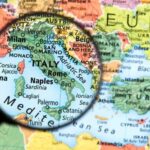Italy has been a popular travel destination for people all over the world, known for its rich history, stunning landscapes, and delicious cuisine. However, with the ongoing COVID-19 pandemic, travelers are facing various restrictions when it comes to visiting this beautiful country. In this article, we will explore the current travel restrictions in Italy and how they are impacting both tourists and local businesses.
As of now, Italy continues to face challenges related to the COVID-19 pandemic, with authorities closely monitoring the situation and implementing necessary measures to ensure public safety. This has resulted in specific entry requirements for travelers, quarantine and testing requirements, as well as restrictions on movement within the country. It is essential for anyone planning a trip to Italy to stay informed about these regulations before making any travel plans.
In addition to understanding the current situation in Italy and entry requirements for travelers, it is crucial to consider the impact these restrictions have on tourism and local businesses. The tourism industry plays a significant role in Italy’s economy, and the limitations imposed due to the pandemic have posed challenges for those who depend on tourism for their livelihoods. Nonetheless, there are still ways for visitors to safely enjoy their time in Italy while adhering to these travel restrictions.
Current Situation in Italy
Italy has been significantly impacted by the COVID-19 pandemic, leading to a series of travel restrictions within the country. As of September 2021, Italy is categorized as a “high-risk” area due to the ongoing spread of the virus. The Italian government has implemented various measures to control the situation and minimize the risk of transmission.
One of the most notable updates includes the introduction of a digital COVID-19 certificate, known as the “Green Pass,” which serves as proof of vaccination, a negative test result, or recovery from the virus. This certificate is required for several activities and services, including indoor dining at restaurants, attending public events, and accessing certain forms of transportation. Additionally, face masks are mandatory in indoor and outdoor settings where social distancing cannot be maintained.
In terms of international travel, Italy imposes specific entry requirements for travelers arriving from different countries. These requirements may include presenting a negative PCR test result taken no longer than 72 hours before arrival, regardless of vaccination status. Travelers may also be subject to health screenings upon arrival and are encouraged to fill out a passenger locator form. It’s important for travelers to stay updated on these requirements as they may change based on evolving circumstances.
| Category | Data |
|---|---|
| Travel Restrictions | Green Pass required for access to various activities |
| International Entry | Negative PCR test required for travelers from certain countries |
| Mandatory Masks | Required in indoor and outdoor settings where distancing is not possible |
Entry Requirements for Travelers
Italy has implemented various travel restrictions in response to the COVID-19 pandemic. As of now, Italy is open to travelers from certain countries, although entry requirements and restrictions are in place to ensure the safety of both visitors and residents.
Currently, travelers from the European Union, Schengen Area, and other approved countries are allowed to enter Italy for tourism purposes. However, there are specific entry requirements that must be met. These include filling out a self-declaration form stating the purpose of the visit and providing proof of a negative COVID-19 test taken within 48 hours prior to arrival.
Additionally, Italy has categorized countries into different lists (A, B, and C) based on their epidemiological situation. Travelers from list C countries may face stricter entry requirements or be subject to quarantine periods upon arrival. It is important for travelers to stay updated on the current categorization of their home country before planning a trip to Italy.
It is essential for travelers to carefully review all entry requirements and restrictions before planning a trip to Italy in order to avoid any disruptions or complications during their visit WHAT ARE ITALY’S TRAVEL RESTRICTIONS?
| Entry Requirements | Details |
|---|---|
| COVID-19 Test | Negative test required within 48 hours of arrival |
| Self-declaration form | Must state purpose of visit |
| Categorization | Countries grouped into lists A, B, and C with varying entry requirements |
Quarantine and Testing Requirements
Quarantine Requirements
Travelers entering Italy from certain countries may be required to quarantine upon arrival. The duration of the quarantine period varies depending on the traveler’s country of origin and specific travel history. It is important for travelers to check the latest updates and guidelines from the Italian government, as well as any requirements set forth by their own country’s government regarding quarantine upon return.
Testing Requirements
In addition to quarantine requirements, travelers may also be subject to COVID-19 testing upon arrival in Italy. This could include a mandatory PCR test or rapid antigen test, depending on the traveler’s circumstances. It is crucial for travelers to confirm the specific testing requirements and protocols in place at their intended destination within Italy, as well as any pre-departure testing that may be necessary before embarking on their trip.
Additional Protocols
It’s also important for travelers to be aware that additional health and safety protocols may be in place at airports, hotels, and other public places throughout Italy. This could include temperature checks, mask mandates, social distancing measures, and enhanced sanitation procedures. Adhering to these protocols is essential for both the safety of travelers and the local community.
As COVID-19 continues to evolve, so do travel restrictions in Italy. It’s crucial for anyone planning a trip to Italy to stay informed about current entry requirements, including quarantine and testing protocols, in order to ensure a safe and smooth travel experience.
Restrictions on Movement Within Italy
Italy has implemented several travel restrictions in response to the COVID-19 pandemic. These measures are aimed at controlling the spread of the virus and ensuring the safety of both residents and visitors. One of the key aspects of these restrictions is the limitation on movement within Italy.
To address this issue, the Italian government has put in place a number of guidelines and regulations that affect how people can travel within the country. Among these restrictions are:
- Regional travel limitations: Italy has implemented a tiered system that divides regions into different zones based on their COVID-19 risk level. This system determines what activities are allowed in each region and restricts movement between regions.
- Curfews: Some areas may have curfews in place, restricting movement during specific hours of the day or night.
- Public transportation limitations: The use of public transportation may be restricted or limited to essential travel only in certain areas.
These measures aim to prevent the spread of COVID-19 by limiting unnecessary movement and interactions among people. It is important for travelers to be aware of these restrictions and plan their itineraries accordingly when visiting Italy.
While these restrictions may impact travel plans, they play a crucial role in safeguarding public health. As such, it is important for travelers to stay informed about the current regulations and comply with them during their visit to Italy.
Overall, understanding and adhering to the regulations concerning movement within Italy is essential for all travelers. By doing so, visitors can ensure a safe and responsible experience while exploring this beautiful country during these challenging times.
Impact on Tourism and Local Businesses
Italy has long been a popular tourist destination, known for its rich history, beautiful architecture, and delicious cuisine. However, the COVID-19 pandemic has significantly impacted the tourism industry in Italy, leading to devastating effects on local businesses. With travel restrictions in place and a decrease in tourist arrivals, many businesses that rely on tourism have been struggling to survive.
Impact on the Tourism Industry
The tourism industry in Italy has been hit hard by the travel restrictions imposed as a result of the pandemic. Hotels, restaurants, tour operators, and other businesses that cater to tourists have seen a sharp decline in revenue. Many tourist attractions and landmarks have also suffered from reduced foot traffic, impacting the overall economy of the country.
Challenges Faced by Local Businesses
Local businesses in Italy are facing numerous challenges due to the travel restrictions. Small family-owned hotels and restaurants have had to reduce their staff or close down completely. Tour operators and guides have experienced cancellations of bookings and tours, leading to financial strain. The lack of international visitors has had a ripple effect on shops and artisans who rely on tourism for their livelihood.
Despite these challenges, some local businesses have adapted by offering virtual experiences or implementing safety measures to attract domestic travelers. However, it is clear that the impact of the travel restrictions on tourism has created significant hardship for many individuals and communities across Italy.
As such, it is crucial for travelers to consider these impacts when planning a trip to Italy during these times. Supporting local businesses through responsible tourism practices can help mitigate some of the adverse effects caused by the ongoing travel restrictions.
Travel Tips for Visiting Italy During the Restrictions
Italy’s travel restrictions have been implemented in response to the ongoing COVID-19 pandemic, with the goal of mitigating the spread of the virus and keeping residents and visitors safe. Despite these restrictions, it is still possible to visit Italy and enjoy its attractions, albeit with some important considerations.
When planning a trip to Italy during the travel restrictions, there are several key tips to keep in mind:
- Stay updated on the latest travel advisories and entry requirements: Before traveling to Italy, it is crucial to stay informed about any changes in entry requirements, quarantine measures, and testing protocols. This information can vary based on the traveler’s country of origin and vaccination status.
- Follow COVID-19 safety guidelines: While in Italy, travelers should adhere to all local health and safety regulations, such as wearing masks in indoor public spaces and maintaining social distancing. It is also advisable to regularly sanitize hands and follow any specific guidelines provided by tourist attractions or accommodations.
Additionally, it is important for travelers to be flexible and prepared for potential changes or disruptions during their visit to Italy. By staying informed, following safety guidelines, and remaining adaptable, visitors can still have a rewarding experience while respecting Italy’s travel restrictions. As the situation continues to evolve, it is essential for travelers to prioritize health and safety while exploring this beautiful country.
Future Outlook and Potential Changes in Restrictions
In conclusion, as Italy continues to navigate its way through the COVID-19 pandemic, it is important for travelers to stay informed about Italy’s travel restrictions. Currently, entry requirements for travelers include presenting a negative COVID-19 test result, completing a self-declaration form, and undergoing a 10-day quarantine upon arrival. Additionally, restrictions on movement within Italy vary depending on the region’s classification under the country’s color-coded system.
The impact of these restrictions on tourism and local businesses has been significant, with many businesses struggling to stay afloat due to the lack of tourists. However, as the vaccination efforts continue and the situation improves, there is hope for potential changes in restrictions in the near future.
For those considering visiting Italy during these uncertain times, it is crucial to stay up to date with the latest travel advisories and guidelines. Travelers should be prepared for possible changes in entry requirements and restrictions on movement within Italy. It is also important to follow all safety protocols and guidelines while traveling to ensure the well-being of oneself and others.
Looking ahead, the future outlook for travel to Italy is hopeful as vaccination rates increase and COVID-19 cases decline. There is anticipation for potential changes in travel restrictions that will allow for a more seamless and enjoyable travel experience in this beautiful country once again. As always, it is advisable for travelers to closely monitor updates from official sources regarding what are Italy’s travel restrictions before planning any trips.
Frequently Asked Questions
Are There Any Travel Restrictions to Italy?
Currently, there are travel restrictions to Italy due to the COVID-19 pandemic. Travelers from certain countries may be required to quarantine upon arrival or provide proof of a negative test result.
What Is Required for a US Citizen to Visit Italy?
For a US citizen to visit Italy, a valid passport is required, with at least six months validity remaining. Depending on the purpose and duration of the visit, a visa may also be necessary. It’s important to check the specific requirements before traveling.
Is There a Travel Warning for Italy?
As of now, there is no travel warning for Italy from the US Department of State. However, travelers are advised to exercise normal precautions due to the current situation with COVID-19. It’s always prudent to stay updated on any travel advisories before planning a trip to Italy or any other country.

I’m a passionate traveler, writer, and Italophile. My fascination with Italy’s history, art, and culture has led me on countless adventures across the Italian landscape. Through “I Live Italy,” I share my love for this extraordinary country and aims to inspire others to explore its boundless beauty.





